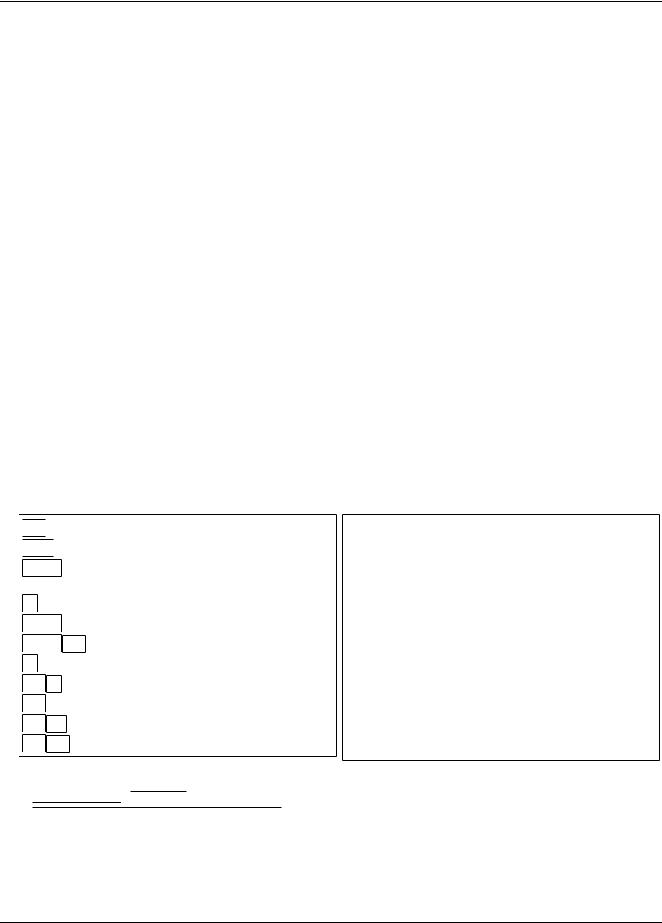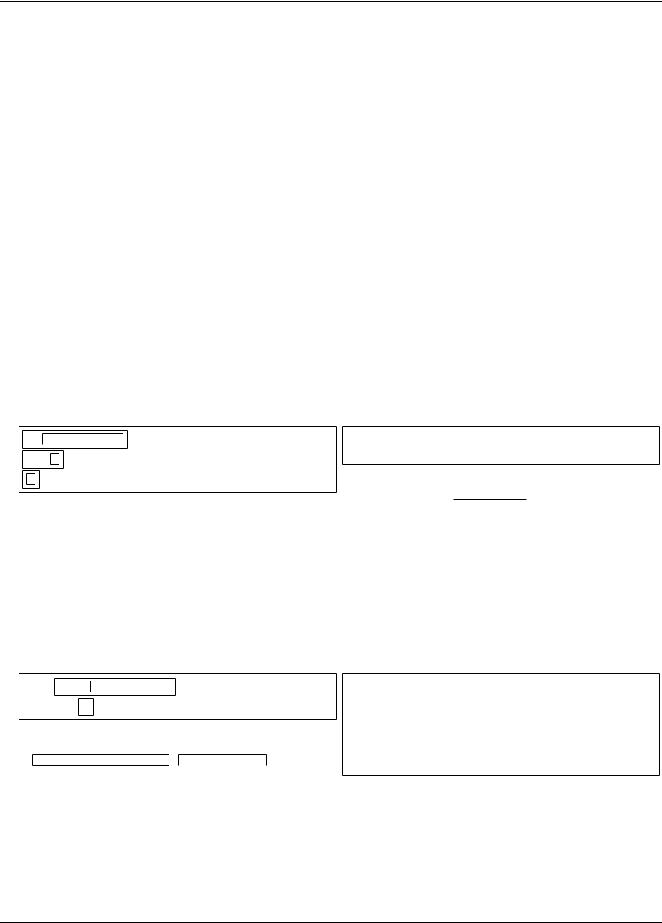
- •Table of Contents
- •Chapter 1. Introduction
- •1.1. Goals
- •1.2. Prior Art
- •1.3. Relation to XML
- •1.4. Terminology
- •Chapter 2. Preview
- •2.1. Collections
- •2.2. Structures
- •2.3. Scalars
- •2.4. Tags
- •2.5. Full Length Example
- •Chapter 3. Processing YAML Information
- •3.1. Processes
- •3.1.1. Represent
- •3.1.2. Serialize
- •3.1.3. Present
- •3.1.4. Parse
- •3.1.5. Compose
- •3.1.6. Construct
- •3.2. Information Models
- •3.2.1. Representation Graph
- •3.2.1.1. Nodes
- •3.2.1.2. Tags
- •3.2.1.3. Nodes Comparison
- •3.2.2. Serialization Tree
- •3.2.2.1. Keys Order
- •3.2.2.2. Anchors and Aliases
- •3.2.3. Presentation Stream
- •3.2.3.1. Node Styles
- •3.2.3.2. Scalar Formats
- •3.2.3.3. Comments
- •3.2.3.4. Directives
- •3.3. Loading Failure Points
- •3.3.1. Well-Formed and Identified
- •3.3.2. Resolved
- •3.3.3. Recognized and Valid
- •3.3.4. Available
- •Chapter 4. Syntax
- •4.1. Characters
- •4.1.1. Character Set
- •4.1.2. Character Encoding
- •4.1.3. Indicator Characters
- •4.1.4. Line Break Characters
- •4.1.5. Miscellaneous Characters
- •4.1.6. Escape Sequences
- •4.2. Syntax Primitives
- •4.2.1. Production Parameters
- •4.2.2. Indentation Spaces
- •4.2.3. Comments
- •4.2.4. Separation Spaces
- •4.2.5. Ignored Line Prefix
- •4.2.6. Line Folding
- •4.3. YAML Character Stream
- •4.3.1. Directives
- •4.3.1.2.1. Tag Prefixes
- •4.3.1.2.2. Tag Handles
- •4.3.2. Document Boundary Markers
- •4.3.3. Documents
- •4.3.4. Complete Stream
- •4.4. Nodes
- •4.4.1. Node Anchors
- •4.4.2. Node Tags
- •4.4.3. Node Content
- •4.4.4. Alias Nodes
- •4.4.5. Complete Nodes
- •4.4.5.1. Flow Nodes
- •4.4.5.2. Block Nodes
- •4.5. Scalar Styles
- •4.5.1. Flow Scalar Styles
- •4.5.1.1. Double Quoted
- •4.5.1.2. Single Quoted
- •4.5.1.3. Plain
- •4.5.2. Block Scalar Header
- •4.5.2.1. Block Style Indicator
- •4.5.2.2. Block Indentation Indicator
- •4.5.2.3. Block Chomping Indicator
- •4.5.3. Block Scalar Styles
- •4.5.3.1. Literal
- •4.5.3.2. Folded
- •4.6. Collection Styles
- •4.6.1. Sequence Styles
- •4.6.1.1. Flow Sequences
- •4.6.1.2. Block Sequences
- •4.6.2. Mapping Styles
- •4.6.2.1. Flow Mappings
- •4.6.2.2. Block Mappings
- •Terms Index

Syntax
•Escaped 16-bit Unicode character:
[63] ns-esc-16-bit ::= “\” “u” ( ns-hex-digit x 4 )
•Escaped 32-bit Unicode character:
[64] ns-esc-32-bit ::= “\” “U” ( ns-hex-digit x 8 )
•Any escaped character:
[65] ns-esc-char ::= ns-esc-null | ns-esc-bell | ns-esc-backspace | ns-esc-horizontal-tab | ns-esc-line-feed
| ns-esc-vertical-tab | ns-esc-form-feed
| ns-esc-carriage-return | ns-esc-escape | ns-esc-space | ns-esc-double-quote | ns-esc-backslash
| ns-esc-next-line | ns-esc-non-breaking-space
| ns-esc-line-separator | ns-esc-paragraph-separator | ns-esc-8-bit | ns-esc-16-bit | ns-esc-32-bit
Example 4.14. Escaped Characters
"Fun with |
\\ |
|
|
|
|
\" |
\a |
\b |
\e |
\f |
\↓ |
\n |
\r |
\t |
\v |
\0 |
\ |
\ |
\_ |
\N |
\L |
\P |
\¶ |
 \x41
\x41 
 \u0041
\u0041 
 \U00000041
\U00000041  "
"
Legend:
 ns-esc-char
ns-esc-char
%YAML 1.1
---
"Fun with \x5C
\x22 \x07 \x08 \x1B \0C \x0A \x0D \x09 \x0B \x00 \x20 \xA0 \x85 \u2028 \u2029 A A A"
Example 4.15. Invalid Escaped Characters
Bad escapes: |
ERROR: |
||
"\ c |
- |
c |
is an invalid escaped character. |
\x q- " |
- |
q |
and - are invalid hex digits. |
4.2. Syntax Primitives
4.2.1. Production Parameters
As YAML's syntax is designed for maximal readability, it makes heavy use of the context that each syntactical entity appears in. For notational compactness, this is expressed using parameterized BNF productions. The set of parameters and the range of allowed values depend on the specific production. The full list of possible parameters and their values is:
Indentation: n or m Since the character stream depends upon indentation level to delineate blocks, many productions are parameterized by it. In some cases, the notations “production(<n)”, “production(≤n)”
30
XSL• FO
RenderX

|
Syntax |
|
and “production(>n)” are used; these are shorthands for “production(m)” for some spe- |
|
cific m where 0 ≤ m < n, 0 ≤ m ≤ n and m > n, respectively. |
Context: c |
YAML supports two groups of contexts, distinguishing between block styles and flow styles. In |
|
the block styles, indentation is used to delineate structure. Due to the fact that the “-” character |
|
denoting a block sequence entry is perceived as an indentation character, some productions distin- |
|
guish between the block-in context (inside a block sequence) and the block-out context (outside |
|
one). In the flow styles, explicit indicators are used to delineate structure. As plain scalars have no |
|
such indicators, they are the most context sensitive, distinguishing between being nested inside a |
|
flow collection (flow-in context) or being outside one (flow-out context). YAML also provides a |
|
terse and intuitive syntax for simple keys. Plain scalars in this (flow-key) context are the most re- |
|
stricted, for readability and implementation reasons. |
(Scalar) Style: s |
Scalar content may be presented in one of five styles: the plain, double quoted and single quoted |
|
flow styles, and the literal and folded block styles. |
(Block) Chomping: t Block scalars offer three possible mechanisms for chomping any trailing line breaks: strip, clip and keep.
4.2.2. Indentation Spaces
In a YAML character stream, structure is often determined from indentation, where indentation is defined as a line break character (or the start of the stream) followed by zero or more space characters. Note that indentation must not contain any tab characters. The amount of indentation is a presentation detail used exclusively to delineate structure and is otherwise ignored. In particular, indentation characters must never be considered part of a node's content information.
[66] s-indent(n) ::= s-ignored-space x n
Example 4.16. Indentation Spaces
 ··
··  # Leading comment line spaces are
# Leading comment line spaces are
 ···
···  # neither content nor indentation.
# neither content nor indentation.
···· |
|
Not indented: |
|
· By one space: | |
|
···· By four |
|
···· ·· spaces |
|
· Flow style: [ |
# Leading spaces |
·· · By two, |
# in flow style |
·· Also by two, |
# are neither |
·· → Still by two |
# content nor |
·· ·· ] |
# indentation. |
Legend:
 s-indent(n)
s-indent(n)
 Content
Content
 Neither content nor indentation
Neither content nor indentation
%YAML 1.1
---
!!map {
? !!str "Not indented"
:!!map {
?!!str "By one space"
:!!str "By four\n spaces\n", ? !!str "Flow style"
:!!seq [
!!str "By two", !!str "Still by two", !!str "Again by two",
]
}
}
In general, a node must be indented further than its parent node. All sibling nodes must use the exact same indentation level, however the content of each sibling node may be further indented independently. The “-”, “?” and “:” characters
31
XSL• FO
RenderX

Syntax
used to denote block collection entries are perceived by people to be part of the indentation. Hence the indentation rules are slightly more flexible when dealing with these indicators. First, a block sequence need not be indented relative to its parent node, unless that node is also a block sequence. Second, compact in-line notations allow a nested collection to begin immediately following the indicator (where the indicator is counted as part of the indentation). This provides for an intuitive collection nesting syntax.
4.2.3. Comments
An explicit comment is is marked by a “#” indicator. Comments are a presentation detail and must have no effect on the serialization tree (and hence the representation graph).
[67] c-nb-comment-text ::= “#” nb-char*
Comments always span to the end of the line.
[68] c-b-comment ::= c-nb-comment-text? b-ignored-any
Outside scalar content, comments may appear on a line of their own, independent of the indentation level. Note that tab characters must not be used and that empty lines outside scalar content are taken to be (empty) comment lines.
[69] l-comment ::= s-ignored-space* c-b-comment
Example 4.17. Comment Lines
··# Comment↓ |
# |
This stream contains no |
···↓ |
# |
documents, only comments. |
↓
Legend:
 c-b-comment
c-b-comment
 l-comment
l-comment
When a comment follows another syntax element, it must be separated from it by space characters. Like the comment itself, such characters are not considered part of the content information.
[70] s-b-comment ::= ( s-ignored-space+ c-nb-comment-text )? b-ignored-any
Example 4.18. Comments Ending a Line
key: ····# Comment↓ |
%YAML 1.1 |
|
|
value ↓ |
--- |
|
|
|
!!map { |
|
|
Legend: |
? !!str |
"key" |
|
: !!str |
"value" |
||
c-nb-comment-text s-b-comment |
|||
} |
|
||
|
|
In most cases, when a line may end with a comment, YAML allows it to be followed by additional comment lines.
[71]c-l-comments ::= c-b-comment l-comment*
[72]s-l-comments ::= s-b-comment l-comment*
32
XSL• FO
RenderX

|
Syntax |
|
Example 4.19. Multi-Line Comments |
||
key: ····# Comment¯ |
%YAML 1.1 |
|
········# lines¯ |
--- |
|
value ¯ |
!!map { |
|
? !!str "key" |
||
¯ |
||
: !!str "value" |
||
|
} |
|
Legend: |
|
|
s-b-comment l-comment |
s-l-comments |
|
4.2.4. Separation Spaces
Outside scalar content, YAML uses space characters for separation between tokens. Note that separation must not contain tab characters. Seperation spaces are a presentation detail used exclusively to delineate structure and are otherwise ignored; in particular, such characters must never be considered part of a node's content information.
[73] s-separate(n,c) ::= c = block-out c = block-in c = flow-out c = flow-in c = flow-key
Þs-separate-lines(n)
Þs-separate-lines(n)
Þs-separate-lines(n)
Þs-separate-lines(n)
Þs-separate-spaces
•YAML usually allows separation spaces to include a comment ending the line and additional comment lines. Note that the token following the separation comment lines must be properly indented, even though there is no such restriction on the separation comment lines themselves.
[74] s-separate-lines(n) ::= |
s-ignored-space+ |
| ( s-l-comments s-indent(n) s-ignored-space* )
•Inside simple keys, however, separation spaces are confined to the current line.
[75] s-separate-spaces ::= s-ignored-space+
33
XSL• FO
RenderX
